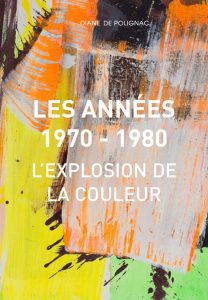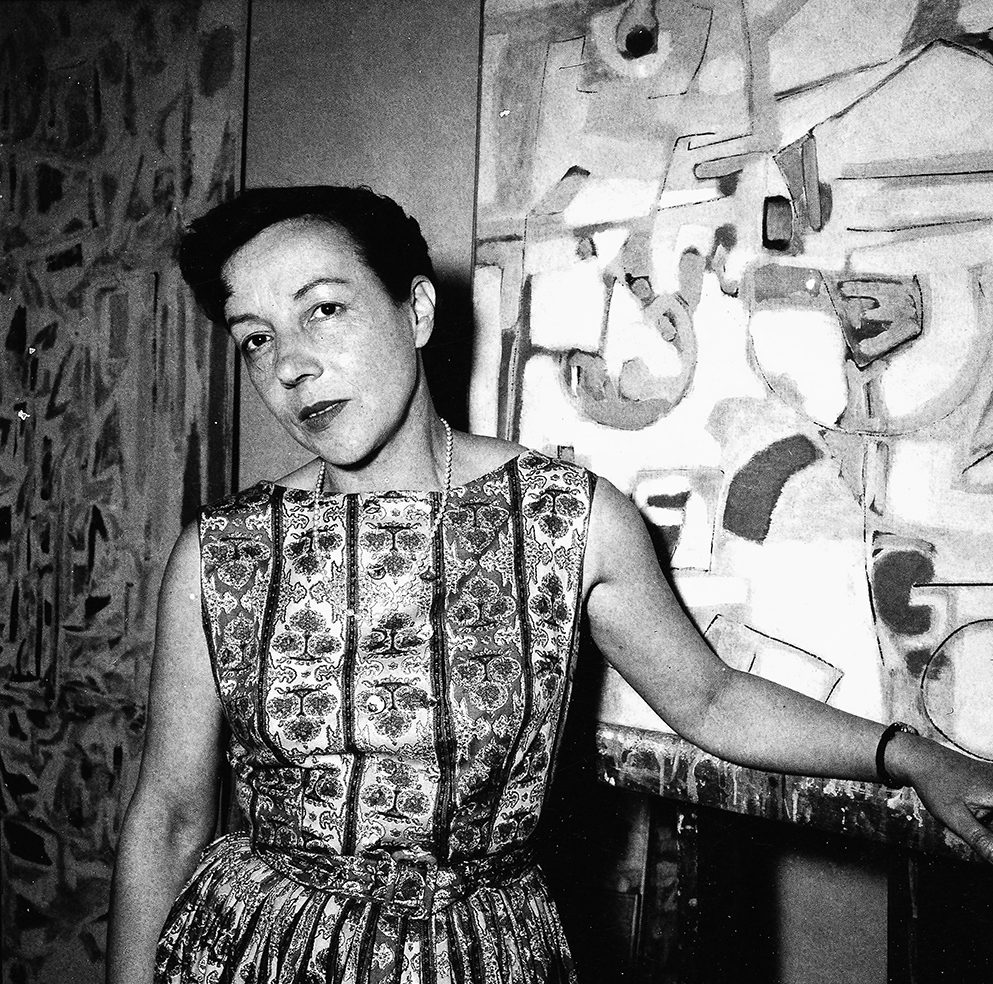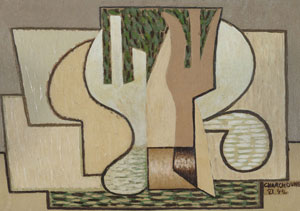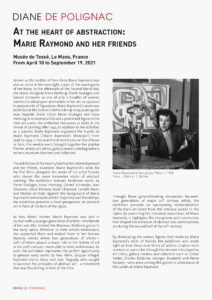
(1908-1989)
The Gallery represents the Estate of the artist Marie Raymond and has been working in partnership with the Marie Raymond Archives since 2019.
Marie Raymond was a French painter and art critic. A prolific and inventive artist, she made a place for herself in the art world of Post-War Paris. She is also the artist Yves Klein’s mother.
Exhibitions
Publications

MARIE RAYMOND
Le royaume invisible
Abstraction-Figures-Astres
Catalog 68 pages – Text by Lucia Pesapane

THE 1940s
An abstract renaissance inspired by surrealist practices
Digital publication – Text by Mathilde Gubanski

LES ANNÉES 1970 – 1980
L’EXPLOSION DE LA COULEUR
Digital publication – Text by Mathilde Gubanski

WOMEN IN ABSTRACT ART:
FIVE WOMEN – FIVE ARTISTIC VISIONS
Digital publication – Text by Mathilde Gubanski

MARIE RAYMOND
To the light
Catalog 60 pages – Text by Michèle Gazier
Videos
Virtual visit of the exhibition “Women in abstract art: Five women – five artisitic visions”.
From March 8 to May 29, 2021
Presentation of the exhibition “MARIE RAYMOND, to the light”
Artwork analysis
The Female Painter Marie Raymond’s Years of Studies
Marie Raymond was born on May 4th, 1908 at La Colle-sur-Loup in the south of France, into a Provencal bourgeois family. Her father was a pharmacist and her grandfather was a flower and perfume merchant. Marie Raymond studied in the Blanche de Castille boarding school in Nice. From her adolescence, she practiced yoga, which was still rare in Europe at the time. This unusual interest in yoga and occultism came from her older sister Rose and her husband, a doctor.
Marie Raymond discovered her vocation for painting on visiting the studio of Alexandre Stoppler, a painter based in Cagnes-sur-Mer. He trained the young artist by getting her to paint directly from life. Her memories of the scents, colours and light of the south of France determined the future development of Marie Raymond’s painting. She wrote: “From my early childhood, the memory of playing among mountains of cut roses that my grandfather bought all over the countryside has remained strong.” The south of France attracted a lot of artists, many whom visited Cagnes-sur-Mer to paint. This is how Marie Raymond met the painter Fred Klein whom she married in 1926. She was just eighteen years old.
Two years later, Fred and Marie had a son: Yves Klein. Marie Raymond had the intuition very quickly that her son would be famous: “I was already aware and desired one day to have a son who would be famous. I have always very clearly remembered a phrase from an Opera I heard in Nice. It was Antar, I think, a phrase stayed in my memory that echoed very strongly in me: ‘and one can, with the beat of a wing, fly away to the Sun’, sung of course. And when I consider life, Yves’s momentum, I can’t help finding in it something like the prescience of destiny which was realized, achieved by Yves Klein’s life in its meteoric evolution.”
Marie Raymond’s Life between Paris and the South of France
The Klein family regularly moved back and forth between Paris and the South, between the desire to live in the art world and economic reality. In Montparnasse, they lived a bohemian life among their friends the artists Jacques Villon, František Kupka, and especially Piet Mondrian with whom Marie Raymond shared her studio. As she described: “It was like a family, many brothers who found each other and had fun in endless conversations. I still remember chatting to Mondrian, at the Dancing de la Coupole. I wasn’t yet twenty, he was sixty, but he was so happy to be dancing.” Between the south of France and the Netherlands, another painter influenced Marie Raymond: Van Gogh, whose Gardener she first saw, in the form of a coloured print, at Jacques Villon’s home.
Back in Nice in 1932, Marie and Fred became close to Nicolas de Staël and his first wife, Janine Teslar. The painter Marie Raymond attended classes at the Nice school of decorative arts where she met the sculptor Émile Gilioli. She was awarded the commission for a fresco for the pavilion of the Alpes-Maritimes at the International Exposition of 1937. In 1938, Fred Klein exhibited in Amsterdam and the family took advantage of this to visit the Netherlands. At the start of the war, the family settled in Cagnes-sur-Mer where Marie Raymond started to paint Imaginary Landscapes (1941-1944), inspired by her wanderings in the hinterland; this is when she met Hans Arp and Alberto Magnelli.
At the end of the war, the woman artist Marie Raymond left her post-Surrealist period and chose abstraction definitively: “gradually, you become internalized, you work. I again sensed the need to express something, but what? The sun still shines! But nothing tangible. How do you recompose life? This is how the first step towards abstract painting is taken.” She made herself a place in the Parisian art scene, which was essentially masculine at the time. Until 1954, Marie Raymond opened her apartment- studio every Monday, creating the “Mondays of Marie Raymond” where the gallerists Colette Allendy, Iris Clert, artists Pierre Soulages, Raymond Hains, François Dufrêne, Jacques de la Villeglé, César, Eugène Ionesco, Jean Tinguely, Hans Hartung, and Nina Kandinsky, as well as the critics Charles Estienne, Pierre Restany, and Georges Boudaille would gather. Pierre Soulages said: “We would go, especially in the evening, for a coffee. We were close, Colette and I, and also our friend Hartung who liked Marie’s painting a lot.”
Marie Raymond was also an art critic. She published many articles, especially in the Dutch magazine Kunst en Kultuur for which she was the Paris correspondent from 1939 to 1958.
Recognition for the painter Marie Raymond
In 1945, Marie Raymond participated in her first major exposition at the Salon des Surindépendants. Her work was hung alongside pieces by Hans Hartung, Jean Dewasne, Jean Deyrolle and Gérard Schneider. The following year, Marie Raymond participated in the exhibition La Jeune Peinture Abstraite at the Galerie Denise René. The same year, she exhibited with Serge Poliakoff and Engel Pak at the Centre de Recherches d’Art Abstrait in Paris and then at the first Salon des Réalités Nouvelles. In 1949, she was awarded the Kandinsky Prize with Youla Chapoval and at the Galerie de Beaune an exhibition was held entitled Les gouaches de Marie Raymond. This woman artist also participated in the first São Paolo Biennale in Brazil.
In 1951, Marie Raymond presented her work with Arp, Doméla, Magnelli, Poliakoff, amongst others at the travelling exhibition Klar Form – 20 Artistes de l’École de Paris organized by Denise René. This exhibition travelled to Copenhagen, Helsinki, Stockholm, Oslo and Liège. In 1952, Marie Raymond exhibited at the Salon de Mai. She interviewed Matisse for the Japanese magazine Mizue.
In 1953, the Klein couple exhibited for three days at the Franco-Japanese Institute of Tokyo and at the Bridgestone Museum of Art in Tokyo. Marie was given a solo show at the Museum of Modern Art of Kamakura.
Fred and Marie participated in 1955 in a travelling exhibition of the Der Kreis (The Circle) Group in Austria and Germany. Marie Raymond then exhibited at the Rio de Janeiro Museum of modern art and at the Lausanne Musée Cantonal. In 1957, an important retrospective called Marie Raymond was held at the Stedelijk Museum in Amsterdam. In 1960, she entered the Marzotto Prize and won a prize for France with the painter Dimitrienko.
At that time, the painter Marie Raymond’s form of abstraction was luminous and lyrical. “For those who haven’t understood the Abstract process, I will try to give a few indications of my working method. After preparing canvases and colours, I would go outside to penetrate myself with the day’s light, walk, even run a little in the Luxembourg gardens near my home, so as to distance myself from the material gesture. For many years, on coming back home, I would focus by reading a few pages from Bergson’s Creative Evolution, which is so full of images, so poetic. With this backbone: having reached a certain internal rhythm, I approached the canvas. A harmony having been revealed, the next stage was tuning and the rhythm of this internal state reached beyond reality and was experienced internally, something beyond the tangible, a chord with ‘the immaterial’ in summary that Yves made light, later on.”
Then came the difficult years for the artist Marie Raymond. The Kleins separated in 1958 and divorced in 1961. The following year, Yves Klein married Rotraut Uecker and died that year of a heart attack at the age of only thirty-four. Marie Raymond said: “Yves had prepared a painting of gold and still had a bouquet of artificial roses separately, taking the bouquet in his hands, he placed it on the painting and asked me the question: “What does this make you think of?” (…) These paintings, he called them “tombs”. Was it a premonition? Because he was in perfect health and very active: This was in the spring, his wife was expecting their child. Who could have foretold that a few months later, he would be carried off so suddenly, in the prime of life, while accomplishing his work.” Marie Raymond’s father also died of a heart attack in 1963.
The artist Marie Raymond’s painting was changed forever by these experiences. The painter found inspiration again in her passion for esotericism and the Cosmos. From 1964, she painted a series of works that she called Abstraction-Figures-Astres. Marie Raymond exhibited at the Galerie Cavalero in Cannes at the Fondation Maeght at Saint Paul-de-Vence and at the Galerie aux Bateliers in Brussels. In 1966, Daniel Templon opened his first gallery, the Galerie Cimaise Bonaparte, with an exhibition of Marie Raymond. In 1972 a major show of her work and of her son, Yves Klein, was organized at the Château-Musée of Cagnes-sur-Mer. In 1988, the Pascal de Sarthe Gallery in San Francisco dedicated a solo exhibition to Marie Raymond. Three times, works by her were shown at the Centre Pompidou in Paris: in 1977, in the exhibition Paris – New York, in 1981, in the exhibition Paris – Paris, Créations en France 1937 – 1957, and finally in 1988 during the exhibition Les années 50. Marie Raymond died the following year in 1989.
© Diane de Polignac Gallery
Translation: Jane Mac Avock

Selected Public Collections
Selected Public Collections
Amsterdam, Stedelijk Museum
Cagnes-sur-Mer, Château-Musée Grimaldi
Nantes, Musée d’Art
Paris, Centre National des Arts Plastiques
Paris, Centre Pompidou
Tokyo, Bridgestone Museum of Art
Selected exhibitions
Selected Exhibitions
12e Salon des Indépendants, Paris, 1945
Galerie Denise René, Paris, 1946, 1947, 1948, 1949, 1953, 1975, 1988
Marie Raymond, Engel Pak, Poliakoff, Centre de Recherches d’Art Abstrait, Paris, 1946
Salon des Réalités Nouvelles, Paris, 1946, 1947, 1948, 1958, 1962, 1968
Prise de terres, Peintres et Sculpteur de l’Objectivité, Galerie Breteau, Paris, 1948
Galerie Colette Allendy, Paris, 1949, 1950, 1956
Galerie de Beaune, Paris, 1949, 1950, 1951
Salon de Mai, Paris, 1952, 1961
Marie Raymond Fred Klein, Bridgestone Museum of Art, Tokyo, 1953
Marie Raymond, Museum of Modern Art, Kamakura, 1953
Marie Raymond Garbell Hillaireau Lyrisme de la Couleur, Galerie Art Vivant, Paris, 1953
Marie Raymond, Galerie du Théâtre de Poche, Brussels, 1954
Du futurisme à l’art abstrait, Musée Cantonal des Beaux-Arts, Lausanne, 1955
Marie Raymond, Stedelijk Museum, Amsterdam, 1957
II Micro-salon di Iris Clert di Iris Clert di Parigi in esclusività per l’Italia, Galerie Apollinaire, Milan, 1957
Galerie Iris Clert, Paris, 1957, 1958
Galerie La Tartaruga, Rome, 1957
Galerie Europe, Brussels, 1959
Marie Raymond, Galerie Cavaléro, Cannes, 1963
Galerie Cimaise Bonaparte, Paris, 1966
Marie Raymond peintures – Dessins, Galerie aux Bateliers, Brussels, 1966
Marie Raymond Yves Klein, Château Musée, Cagnes sur Mer, 1972
1ère Biennale française de la tapisserie en hommage à Jean Lurçat, Palais de l’Europe, Menton, 1975
IIème Biennale Française de la Tapisserie en hommage à Le Corbusier, Palais de Juan-les-Pins, Antibes, 1977
Centre Georges Pompidou, Paris, 1977, 1981, 1988
Charles Estienne et l’art à Paris 1945-1966, Centre National des Arts Plastiques, Paris, 1984
La part des femmes dans l’art contemporain, Vitry-sur-Seine, 1984
Aspects de l’art en France de 1950 à 1980, Musée Ingres, Montauban, 1985
Hommage à Iris Clert, Acropolis, Nice, 1986
L’Art en Europe – Les années décisives 1945-1953, Musée d’Art Moderne, Saint-Étienne, 1987
Abstraction expressions – confrontations 1950-1970, Galerie Bernard Davignon, Paris, 1988
Pascal de Sarthe Gallery, San Francisco, 1988, 1991
Marie Raymond, Rétrospective 1937-1987, Musée d’Art Moderne et d’Art Contemporain, Nice, 1993
L’École de Paris – 1945-1964, Musée National d’histoire et d’art, Luxembourg, 1998
Marie Raymond – Yves Klein, Musée des Beaux-Arts, Angers, 2004
Marie Raymond – Yves Klein, Musée des Beaux-Arts, Carcassonne, 2006
Marie Raymond – Yves Klein, Museum Ludwig, Koblenz, 2006
Marie Raymond – Yves Klein, LAAC Dunkerque, Dunkirk, 2007
Marie Raymond – Yves Klein Herencias, Circulo de Bellas Arte, Madrid, 2010
Marie Raymond – Vers la Lumière, Galerie Diane de Polignac, Paris, 2019
ABSTRAITES : Cinq femmes – cinq expressions artistiques, Galerie Diane de Polignac, Paris, 2021
Les années 1970 – 1980, L’explosion de la couleur, Galerie Diane de Polignac, Paris, 2021
Les années 1940, Quand les procédés surréalistes permettent l’abstraction, Galerie Diane de Polignac, Paris, 2022
Marie Raymond, Le Royaume invisible, Abstraction-Figures-Astres, Galerie Diane de Polignac, Paris, 2023
Action, Geste, Peinture : Femmes dans l’abstraction, une histoire mondiale (1940-1970), Fondation Vincent Van Gogh, Arles, 2023
Seffa Klein, A Family Constellation, Galerie Poggi, 2024
Selected Bibliography
Selected Bibliography
Marie Raymond, Abstraction, Lyrisme, Vérité…, in Kroniek Van Kunst En Kultuur, n°15, juin 1939
Charles Estienne, Léon Degand, Pour ou contre l’art abstrait, Paris, Le Courneur, 1947
Marie Raymond, Les Origines de l’Art abstrait, in Kroniek Van Kunst En Kultuur, n°9, September 1949
Marie Raymond, Soulages à la Galerie Lydia Conti, Vieira da Silva à la Galerie Pierre, in Kroniek Van Kunst En Kultuur, n°11, November 1949
Charles Estienne, L’art Abstrait est-il un Académisme?, Paris, Éditions de Beaune, 1950
Michel Ragon, Expression et Non-Figuration, Paris, Éditions de la Revue, 1950
Pierre Francastel, Peinture et Société, Lyon, Éditions Audin, 1951
Léon Degand, Julien Alvard, R. Van Gindertael, Témoignage pour l’Art Abstrait, Paris, Art d’Aujourd’hui, n° 1, 1952
Pierre Courthion, Peinture d’aujourd’hui, Geneva, Éditions Pierre Caillier, 1952
Marie Raymond, Interview avec Henri Matisse, in Mizue (monthly art magazine), Tokyo, n°571, March 1953
Robert Lebel, Pierre Descargues, R. Van Gindertael, Premier bilan de l’art actuel, Paris, Éditions Le Soleil Noir, 1953
Renée Huyghe, Dialogue avec le Visible, Paris, Éditions Flammarion, 1955
Michel Ragon, L’Aventure de l’Art Abstrait, Paris, Éditions Robert Laffont, 1956
Marcel Brion, L’Abstraction, Paris, Éditions Aimery Somogy, 1956
Jean Bouret, L’Art Abstrait: ses Origines, ses Luttes, sa Présence, Paris, Éditions Club Français du Livre, 1957
Michel Seuphor, Dictionnaire de la Peinture Abstraite, Paris, Éditions Fernand Hazan, 1957
Bernard Dorival, Les Peintres du XXe Siècle, Paris, Éditions Tisné, 1957
Gabrielle Buffet-Picabia, Aires Abstraites, Geneva, Éditions Pierre Caillier, 1957
Michel Ragon, La Peinture Actuelle, Paris, Éditions Berger- Levrault, 1959
Pierre Restany, Lyrisme et Abstraction, Milan, Éditions Apollinaire, 1960
Jean Cassou, Panorama des Arts Plastiques Contemporains, Paris, Éditions Gallimard, 1960
Michel Ragon, Naissance d’un Art Nouveau – Tendances et Techniques de l’Art, Paris, Éditions Albin Michel, 1963
Raymond Bayer, Entretiens sur l’Art Abstrait, Geneva, Éditions Pierre Caillier, 1964
Michel Seuphor, La Peinture Abstraite, sa Genèse, son Expansion, Paris, Éditions Flammarion, 1964
Herbert Read, Histoire de la Peinture Moderne, Paris, Éditions Somogy, 1966
Dora Vallier, L’Art Abstrait, Paris, Éditions Le Livre de Poche, 1967
Michel Ragon, Michel Seuphor, L’Art Abstrait 1939- 1970, Paris, Éditions Galerie Maeght, vol. III, 1973
Marie Raymond, Au Grand-Palais, la FIAC 79 – Les Fantasmes de Picasso, in + – O, n°29, April 1980
Michel Ragon, 25 Ans d’Art Vivant 1944-1969, Paris, Éditions Galilée, 1986
Marie Raymond Forty Years of Abstract Painting, San Francisco, Pascal de Sarthe Gallery, 1988
Geneviève Bonnefoi, Les Années Fertiles 1940-1960, Paris, Mouvements Éditions, 1988
Jean-Luc Daval, Histoire de la Peinture Abstraite, Paris, Éditions Fernand Hazan, 1988
Georges Boudaille, Patrick Javault, L’Art Abstrait, Paris, Nouvelles Éditions françaises, 1990
Marie Raymond Rétrospective 1937-1987, Nice, MAMAC, 1993
Lydia Harambourg, L’École de Paris 1945-1965 Dictionnaire des Peintres, Neuchâtel, Éditions Ides et Calendes, 1993
Marie Raymond / Yves Klein, Kerber Verlag, Bielefeld / Ludwig Museum, Koblenz,2006
Marie Raymond – Yves Klein Herencias, Madrid, Circulo de Bellas Arte, 2009
Lydia Harambourg, L’École de Paris, 1945-1965, Dictionnaire des peintres, Ides et Calendes, Neuchâtel, 1993, (update by Clotilde Scordia, Ides et Calendes, Neuchâtel, 2010)
Marie Raymond – Vers la Lumière, Paris, Galerie Diane de Polignac, 2019
Marie Raymond Faq
On the MARIE RAYMOND FAQ page, find all the questions and answers dedicated to the modern art painter Marie Raymond.



















